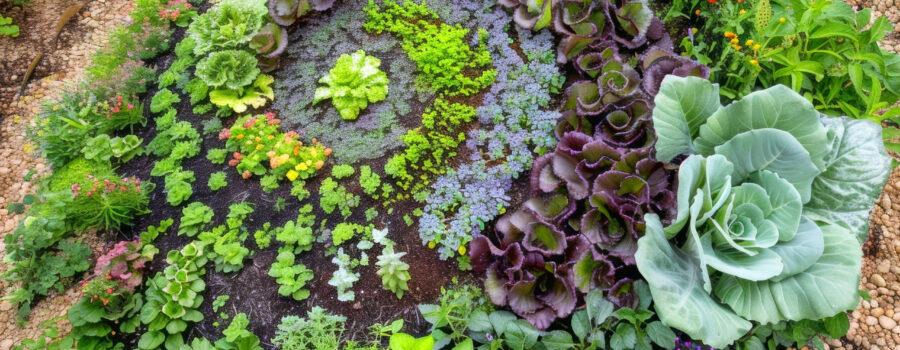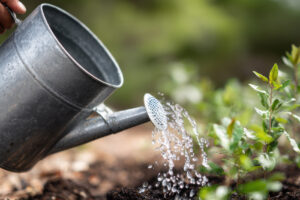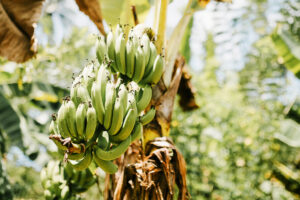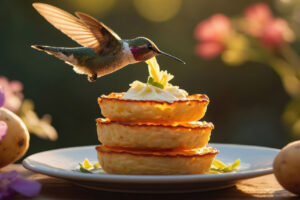Companion planting and tree guilds are powerful tools for creating resilient and productive food forests. Nature already has a system in place, and while there is no set formula, emulating this process in an intentional way provides many benefits when first establishing or expanding planting areas. By understanding the principles of companion planting and applying them in thoughtful guild design, we can create edible landscapes that are not only productive but also regenerative and resilient.
What is Companion Planting?
Indigenous cultures, more aligned with the natural world than we often are today, applied what they observed in nature to growing food. We are beginning to return to the wisdom of polyculture, the practice of growing multiple compatible crops together in the same space, instead of the monoculture rows of single crops that often rely on synthetic pesticides and fertilizers to survive. Native Americans cultivated the “Three Sisters” — their main food staples of corn, beans, and squash — to mutually support each other. The corn provided a trellis for beans, beans fixed nitrogen into the soil, and squash suppressed weeds and retained moisture with its broad leaves.
In permaculture, companion planting draws on relationships between plants, insects, soil organisms, and environmental conditions. Combining a diverse grouping of plants can enhance growth, deter pests, attract beneficial insects, and improve soil fertility.
Guilds: Companion Planting with a Purpose
A plant guild is a group of species that work together to support a central plant, usually a fruit or nut tree. Each member of the guild performs a specific function: attracting pollinators, fixing nitrogen, repelling pests, mulching the soil, or accumulating nutrients from deep within the ground to provide mutual support.
Guilds are a powerful tool in permaculture design because they can eliminate the need for external inputs like fertilizers and pesticides. They can create resilience against pests. Flowering plants like yarrow, dill, and fennel attract pollinators and predators like ladybugs and parasitic wasps.
Every year, right after my Chickasaw Plum leafs out in the spring, aphids appear on the new growth. I don’t bother spraying them off. Ladybugs arrive shortly after to eat them and will reproduce there on the tree until the food source is depleted. It’s fun to observe the various stages of their growth, and I’m happy to leave some aphid-filled branches for them.
Wasps, bees, and even a few butterflies also arrive to feed on the aphid “honeydew” left behind. These pollinators visit other plants in the guild while they are there. The predatory wasps will also eliminate harmful insects. Left to its own devices, nature does it best, so I do my best not to get in the way!

Key Roles in a Permaculture Guild
To build a successful guild, it helps to understand the basic roles that various plants play in the system:
- The Central Element
Typically a fruit tree like a peach or plum will be planted as the main feature. - Nitrogen Fixers
Legumes like beans or peas are commonly used to enrich the soil by capturing atmospheric nitrogen and making it available to other plants (can also be ground covers like perennial peanut). - Dynamic Accumulators
Deep-rooted plants such as comfrey, yarrow, and dandelion draw nutrients from subsoil layers and make them available on the surface when their leaves decompose. - Mulch Plants
Ground covers like nasturtium, sweet potato, or white clover help retain moisture, suppress weeds, and build organic matter. - Pollinator Attractors
Flowers such as calendula, echinacea, and bee balm support bees, butterflies, and other beneficial insects. (They may also be harvested for medicinal use.) - Pest Repellents
Aromatic herbs like garlic, chives, marigold, and basil can deter pests with their strong scents and compounds. - Ground Covers
Plants that spread low to the ground and protect soil structure. Examples include creeping thyme, perennial peanut, sweet potatoes, or strawberries. - Climbers/Vines
Vertical space can be used for vines like grapes, butterfly pea, runner beans, or coral honeysuckle which can climb the central tree or nearby supports.

Example: Citrus Tree Guild
Well-chosen companion plants will not only provide food or medicine, but also pollination, fertilizer, and disease control. A successful guild will keep your food forest healthy and low-maintenance. Each component should work to enhance the health and productivity of the whole. A diversity of plant choices will make the system more resilient to environmental stressors like drought, pests, and disease.
For a citrus tree guild, these plants make great companions:
- Comfrey – medicinal, a dynamic accumulator that offers chop and drop mulch, acts as a fertilizer, and attracts pollinators
- Yarrow – medicinal, a dynamic accumulator that attracts beneficial insects
- Creeping Thyme – a ground cover that offers weed suppression
- Oregano – edible ground cover that repels pests
- Calendula – medicinal, pollinator attractor
- Garlic / Onions / Chives – Edible pest deterrents
This guild not only supports the health of the citrus tree but also produces multiple yields: fruit, medicinal and culinary herbs, chop and drop mulch, and beneficial insect habitat. Guilds should contribute to a more self-sufficient and sustainable system.
Tips for Designing Companion Planting Guilds
Designing a guild is more art than science, but here are a few guiding principles:
- Start Small: Focus on one tree and its immediate surroundings before scaling up.
- Observe and Interact: Watch how plants respond to each other over a full four seasons.
- Stack Functions: Prioritize plants that serve multiple roles (like comfrey is a mulch plant, dynamic accumulator, and pollinator attractor).
- Plan for Succession: Include short-lived annuals alongside perennials to fill gaps in early growth stages.
- Encourage Diversity: A variety of species enhances resilience and pest control.

Fruitful Food Forestry has a store!
We think you might like what we’re “petaling”…
Common Companion Pairings
Here are some well-known companion plant combos to inspire your guild designs:
- Tomato + Basil + Marigold
Basil enhances tomato flavor and deters pests; marigold repels nematodes. - Corn + Beans + Squash (Three Sisters)
Classic indigenous trio with multiple mutual benefits. - Cabbage + Dill + Nasturtium
Dill attracts beneficial insects; nasturtium draws aphids away from cabbage. - Carrot + Onion + Rosemary
Onion and rosemary repel carrot flies and improve flavor.
Challenges and Considerations
While companion planting and guilds offer many benefits, they also need ongoing observation and management. Issues to watch out for include:
- Overcrowding: Too many plants too close together can lead to competition for resources.
- Allelopathy: Some plants release chemicals that inhibit the growth of others (like black walnut or sunflowers).
- Invasive Species: Avoid overly aggressive ground covers that can take over your guild if planted in the ground (think mint). Keep an eye on plants like Wild Taro, Winged Yam, and Surinam Cherry.
- Changing Needs: As trees mature, shade patterns and space availability will shift.
Embrace What Works Naturally
We can reclaim this connection to nature that our ancestors so easily understood, embracing the fact that we are a part of the natural world instead of separate from it. Or, we can at least make strides in that direction, beginning with growing at least part of what we eat in our own back yards.
Understanding the basics of companion planting is helpful in this process, but experimentation and personal tastes are also important factors, so don’t overthink it. Observe what works naturally in your area, explore your options, plant what you enjoy eating, then adjust over time to grow what works best for you.
Copyright © 2025 Fruitful Food Forestry & Lauren Lynch. No portion of the original content on this website may be reproduced, in any language, without express written consent.









Leave a Reply
Your email is safe with us.